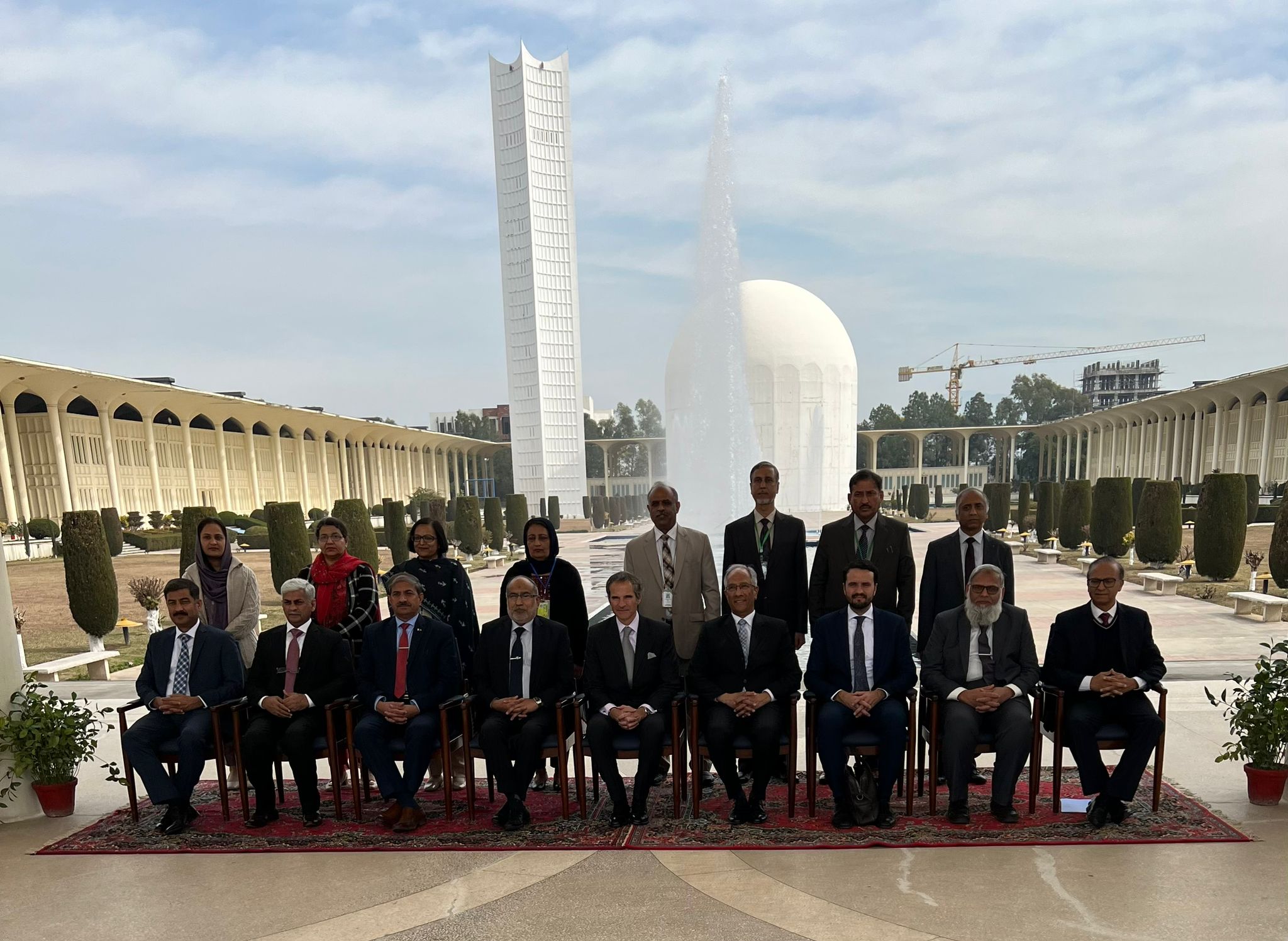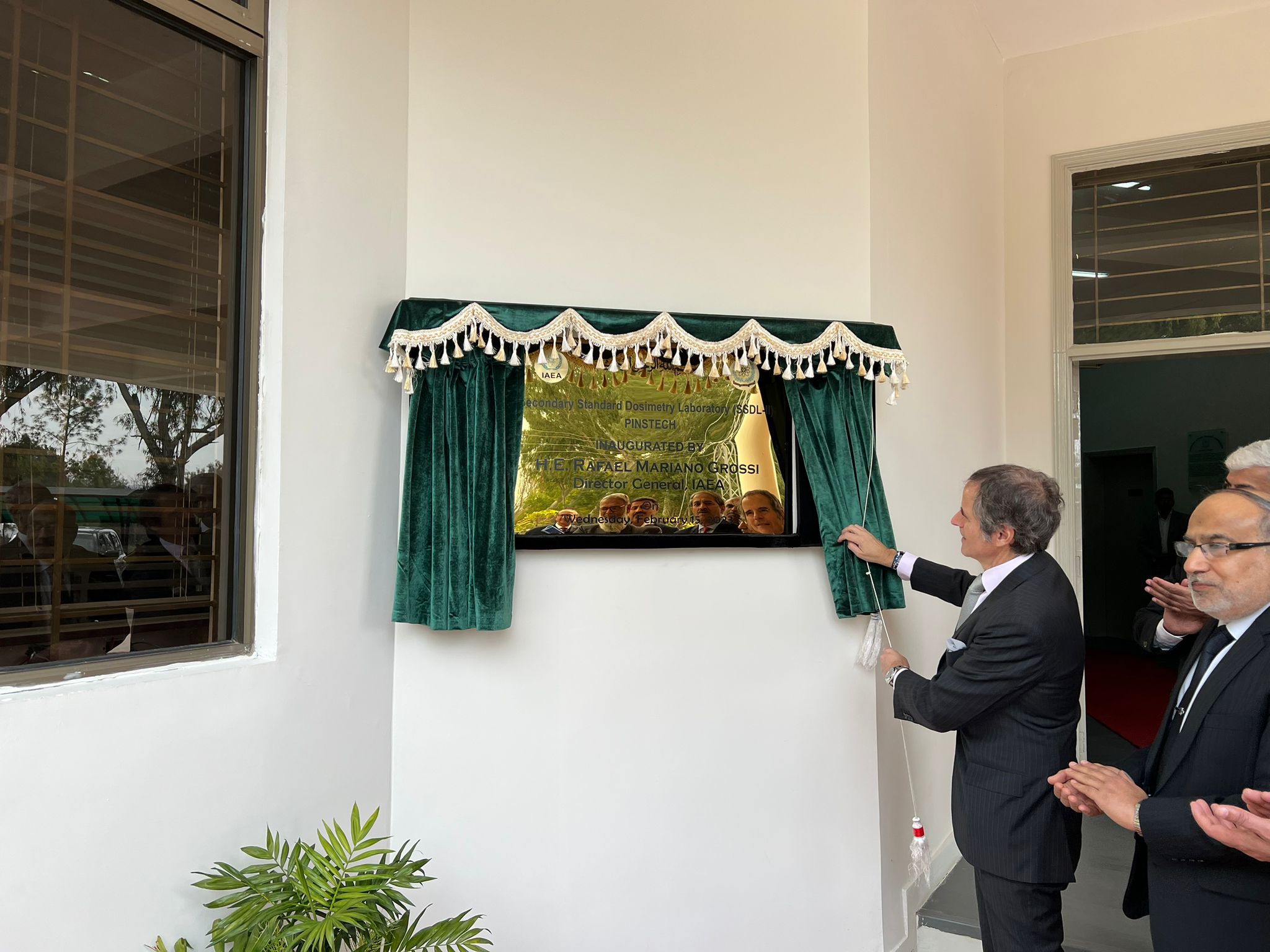Pakistan, China agree to build Chashma 5
23 November 2017
China National Nuclear Corporation (CNNC) and the Pakistan Atomic Energy Commission (PAEC) have signed a cooperation agreement on the construction of a HPR1000 Hualong One reactor at the Chashma nuclear power plant.
|
|
| The agreement was signed by the chairmen of CNNC and PAEC (Image: CNNC) |
"According to the agreement, CNNC will build a one-million-kilowatt-class nuclear power unit with HPR1000 technology at the Chashma Nuclear Power Plant in Pakistan," CNNC said yesterday. The reactor will be the seventh nuclear power unit that China has exported to Pakistan and the third HPR1000.
The Chinese-designed HPR1000 Hualong One reactor design is under construction in China, at Fuqing units 5 and 6 and Fangchenggang units 3 and 4. The first Hualong One unit, Fuqing 5, is expected to start up in 2019, with Fangchenggang 3 to follow the same year, and the other two units in 2020.
Chashma is already home to four Chinese-built CNP-300 units, while two HPR1000 units are under construction at Pakistan's Karachi nuclear power plant. Construction began on Karachi unit 2 in 2015 and unit 3 in 2016; the units are planned to enter commercial operation in 2021 and 2022, respectively.
The HPR1000 has also been proposed for construction at Bradwell in the UK, where it is undergoing Generic Design Assessment. UK national regulatory bodies the Office for Nuclear Regulation and the Environment Agency recently announced the start of the second, technical, phase of the assessment programme for the UK HPR1000.
Chashma 5 will be constructed by CNNC subsidiary CNNC China Zhongyuan Engineering Corp, the company said.
Research and development
The Pakistan Institute of Nuclear Science & Technology (PINSTECH) at Rawalpindi near Islamabad is managed by the PAEC and is one of the largest science and technology research establishments in the country. It has conducted research into reprocessing used nuclear fuel, though today it claims to be focused on research in medicine, biology, materials and physics, including production of medical radioisotopes.
Pakistan has a 10 MW pool-type research reactor, PARR-1, of 1965 vintage, supplied by the USA under the Atoms for Peace program. It was converted to use low-enriched uranium fuel in 1991, and upgraded from 5 to 10 MW. PARR-2 is an indigenous 30 kW miniature neutron source reactor (MNSR) based on Chinese design and using high-enriched fuel operating since 1974. Both are located at the PINSTECH Laboratory, Nilore, near Islamabad. They are under IAEA safeguards. One of them produces some Mo-99 from HEU targets.
New Labs at PINSTECH in Rawalpindi is reported to be a reprocessing plant for weapons-grade plutonium production, and not under safeguards. It is run by PAEC and operational since 1981. This was apparently the culmination of a plutonium weapons program predating the Kahuta HEU weapons program, and replaced an unfinished much larger reprocessing plant (100 t/yr) being built at Chashma by France, but cancelled in 1978.
At Khushab, 200 km south of Islamabad, there are four heavy water reactors dedicated to production of weapons-grade plutonium, plus a heavy water plant. The first of these, a 'multipurpose' PHWR estimated at 30-40 MWt, started operating in 1998. Then a larger (40-50 MWt) heavy water reactor was built there from about 2002, and appeared to be operational at the end of 2009. In 2006, construction started on a third reactor, similar to and adjacent to the second, and this appeared to be operational by the end of 2013. A similar but larger (90 MWt) fourth reactor was built from 2011 a few hundred metres away, and appeared to be operational in January 2015. These seem to add up to a substantial plutonium production capacity. Khushab is reported to be making demands upon the country's limited uranium resources. A small heavy water plant is nearby.
Reprocessing of military material is reported to take place at Chashma, 80 km west, and the original French reprocessing plant is apparently under renewed construction there, a couple of kilometres southwest of Chashma 1-4 power reactors.
The Khan Research Laboratories (KRL) at Kahuta in Punjab is described as a weapons engineering R&D institute and research laboratory, focused on producing high-enriched uranium using centrifuge technology originally stolen from Urenco by Dr Abdul Q Khan. Set up about 1976 as the Engineering Research Laboratories it was a key part of Pakistan's weapons program, supported by the Army Corps of Engineers in competition with the plutonium program being pursued by PAEC. It was renamed in honour of Dr Khan in 1981.
Regulation
The Pakistan Nuclear Regulatory Authority (PNRA) is responsible for licensing and supervision, and regulates the safety and security of all civil nuclear materials and facilities. In respect to the Chashma reactors, and presumably also the Karachi Coastal power project, it works closely with China's National Nuclear Safety Administration. It was formed in 2001, superseding the Pakistan Nuclear Regulatory Board (set up by PAEC) and the Directorate of Nuclear Safety and Radiation Protection.
Pakistan is party to the Convention on Nuclear Safety and two international conventions for early notification and assistance.
Non-proliferation
Pakistan is not party to the Nuclear Non-Proliferation Treaty (NPT) but does have its civil power reactors and two research reactors (PARR 1&2) under item-specific IAEA safeguards. An agreement for two further 340 MWe reactors – Chashma 3&4 – came into force in April 2011. In March 2017 the IAEA approved Pakistan’s request to apply international safeguards to both Karachi Coastal units, and the agreement on this came into force in May. Pakistan has refused calls for international inspections of its enrichment activities.
The Institute for Science and International Security (ISIS) said in May 2018: "Unlike India, Pakistan has barely separated its civil and military nuclear facilities and in general remains highly secretive about its nuclear program. The opaqueness of Pakistan's nuclear program, its expanding nuclear weapons arsenal, and its refusal to separate its military and civilian nuclear program are cited as reasons by many countries opposing Pakistan's membership of the Nuclear Suppliers Group (NSG), as well as [opposing] any country supplying it with additional nuclear power reactors or other fuel cycle facilities or capabilities. Such supply is viewed by many countries as a violation of NSG guidelines."
Pakistan's Kahuta project (incorporating Project-706) to produce a uranium bomb was launched in 1972, following a disastrous war with India. It was partly financed by Libya to 1979. In May 1974 India exploded a nuclear test close to the Pakistan border, galvanising Pakistani efforts. The project was disbanded in 1983 after a successful cold test of weapons components.
In May 1998 Pakistan exploded five atomic devices in Baluchistan. At least one was evidently made from enriched uranium, but the Chagai II test in Kharan desert used plutonium produced by New Labs.
Pakistan is reported to be the sole nation blocking agreement of the Fissile Material Cutoff Treaty (FMCT) in Geneva negotiations.
Through the activities of Dr Khan, a centrifuge plant and nuclear weapons designs were secretly supplied to Libya from the late 1990s to 2003 to help build a weapons program there. He also transferred centrifuge technology to North Korea in the 1990s, and to Iran. This is the main basis for the NSG refusing to ease nuclear trade sanctions for Pakistan, as it has for India. China is the only country to act in defiance of trade sanctions, and has deepened cooperation since the international US-led concessions to India in 2008. This is most obvious in 2013 agreements to build the twin-unit Karachi Coastal power plant and the CNNC contract with PAEC for lifetime fuel supply for this.
Addressing the 3rd Nuclear Security Summit at The Hague in March 2014, the prime minister said that Pakistan had been running a safe and secure nuclear program for over four decades with the expertise, manpower and infrastructure to produce civil nuclear energy. He called for Pakistan’s inclusion in all international export control regimes, especially the NSG. He pointed out that international treaties and forums would supplement Pakistan’s national actions to fortify nuclear security.
Domestically, he said that today the country’s nuclear security is supported by five pillars – a strong command and control system led by the National Command Authority (NCA); an integrated intelligence system; a rigorous regulatory regime; a comprehensive export control regime; and active international cooperation. The security regime covers physical protection, material control and accounting, border controls and radiological emergencies, he said.
Pakistan is a major recipient of technical cooperation from the IAEA, and is one of 35 members of the IAEA Board of Governors, though it remains outside the NPT.



%20460.jpg)



